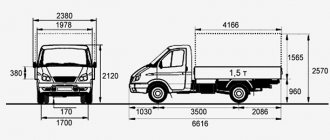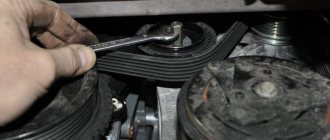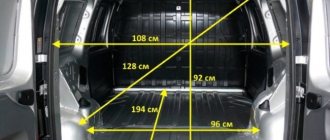04 May 2018 Lada.Online 39 638 7
Lada Vesta CNG is a modification that allows the use of two types of fuel: compressed natural gas (methane) and gasoline. One of the main advantages of this version is cost-effectiveness. We decided to find out what the real fuel consumption and range of the Lada Vesta with LPG is.
It is worth noting that when using gas, the system still consumes gasoline. This was done to reduce the combustion temperature of the mixture, which reduces the thermal effect on the engine when using gas. According to rough estimates, gasoline consumption is 1-1.5 l/100 km.
Fuel consumption from technical specifications
:
- Urban cycle, l/100 km — 10.1
- Urban cycle, m3/100 km - 8.1
- Extra-urban cycle, l/100 km — 6.0
- Extra-urban cycle, m3/100 km - 5.2
- Combined cycle, l/100 km - 7.5
- Combined cycle, m3/100 km - 6.3
Dimensions of the new body with gas equipment and other characteristics
Vesta cng is equipped with a VAZ 21129 engine. This is a 1.6-liter engine with a capacity of 106 horsepower and a torque range of 135 Nm. Vesta is available in four trim levels with different levels of comfort. All Cngs come off the production line with a 5MT manual transmission. When using different fuels, only acceleration will differ (on gas - 12.9, on gasoline - 11.8 seconds from 0 to 100 km/h). Maximum speed (methane - 170, liquid fuel - 175). The description of the external technical characteristics of CNG is no different from the parameters of a regular Lada Vesta, except for the presence of an additional filler hole under the gas tank cap. All dimensions of Vesta remained the same (length - 4410 mm, width - 1764 mm, height - 1497 mm, ground clearance - 178 mm, gas tank volume - 55 liters).
Engine VAZ 21129
Before us is a modification of the VAZ 21127 engine and it was installed on the first LADA Vesta cars. Among the main distinctive features of this unit are the following:
- low fuel consumption;
- suspension improvements;
- low level of noise, knocking and toxicity;
- modified gas exhaust and intake system.
VAZ 21129 has not yet entered service, but the previous model, 21127, has proven itself to be very good. If desired, the car owner can easily increase the power to 150 horsepower.
For this engine, the manufacturer installed two gearboxes at once - manual and AMT (robotic gearbox). Fuel consumption on both boxes is the same - 10 liters within the city and 6 liters on the highway.
New Lada: Lada Granta automatic transmission repair in Tomsk. Affordable prices on PROFI.RU. Read reviews, choose according to specialist ratings
Propane or methane
Initially, all Lada Vesta engines were designed with great potential for various modifications, including the installation of other power plants. New Vesta is immediately produced with two fuel systems - using gasoline and using natural compressed gas. Lada uses only methane. It is less explosive than propane and complies not only with existing European toxicity standards, but also with their prospects. Compressed natural gas reduces fuel costs by 3.5 times and increases engine life.
Pros and cons of methane gas treatment
Lada Vesta on methane is a very economical car. The manufacturer claims that Vesta is capable of traveling 1000 km without refueling. It turns out that less fuel is consumed than usual, while at the same time methane costs 4 times less than 95 gasoline, which is recommended to fuel the new Lad family. One kilometer of travel on gas costs 1 ruble.
The life of the engine is extended due to the gaseous state of the fuel. Liquid fuel washes away the oil film from the walls of the cylinder liners, forms deposits - sooner or later carbon deposits appear. Methane has completely different properties - it does not affect the components of the engine in any way. However, natural gas reaches high temperatures. To cool the air-fuel mixture, and with it the space above the piston, the system provides for rare injection of gasoline while driving on LPG. This engineering solution also increases the resource of the engine, protecting it from overheating. The Lada starts with gasoline, only then the gas is connected - this is done because the engine and gas need to warm up a little.
Methane tends to dissipate, it is not heavy and does not accumulate in lowlands. From this point of view, if it leaks, it is safer than any other fuel. The entire fuel line is built safely: from the spherical gas cylinder (this shape is preferable for methane) to the controller in the engine compartment. It shuts off the gas at any even slightly increased flow rate.
A big plus is that such gas-cylinder equipment is factory-made, that is, it has a guarantee, and there will be no problems with it in the registration of the car. There is no need to modify the mechanical part of the engine to accommodate it, and there is no risk of unsuccessful installation of gas equipment. A good bonus to this is the filling nipple located in the gas tank flap (on non-factory systems it is in the trunk).
Refilling with methane is quick, about 10 minutes. This time depends on the operating pressure at the filling station, the ambient temperature and the fullness of the gas tank. By the way, the operating temperature for methane is from -40 to +55 degrees Celsius.
The biggest disadvantage of this Vesta is the low density of methane CNG filling stations (automobile gas filling compressor stations) throughout Russia. More often than not, such gas stations are geographically located near the methane pipeline, and these are far from the most convenient places.
The cylinder in a sedan takes up a lot of space both in the trunk and in the rear of the cabin. Because of it, the backs of the seats do not recline, a couple of bags can fit on the shelf, and several bottles of water can be stored in the trunk.
Technical characteristics of Lada Vesta on methane
Lada Vesta CNG is equipped with a 1.6 liter dual-fuel engine and a five-speed manual transmission. The maximum speed when using gasoline is 175 km/h, gas - 170 km/h. The power of the power plant when driving on gasoline is 106 kW. When switching to methane, the figures drop to 96 kW.
The gas fuel refill compartment is located directly behind the gas tank hatch. The modified version of the car is equipped with a factory-installed Italian-made gas system; a 90-liter gas cylinder is located behind the rear seats. To increase the safety level of the tank, the cylinder is equipped with high-speed valves and a special fuse that prevents it from rupture and methane leakage. This arrangement of the volumetric cylinder significantly reduced the available space in the luggage compartment and made it impossible to transform the rear row of seats. Significant advantages were the absence of the need for maintenance of the gas reducer, fuel rail and the long service life of the cylinder (15 years). When ignited, this model uses exclusively gasoline fuel, after which the vehicle automatically switches to gas. Manufacturers have provided another important automated process - switching from gasoline to methane, in the case of the end of the former in the tank. The Lada Vesta functionality includes the ability to manually switch work from gasoline to gas and vice versa. The car accelerates to a speed of 100 km/h (when using gasoline) in 11.8 seconds. methane slightly increases these figures to 13c. The average methane consumption is 6.3 m3. Otherwise, the modified model is no different from its predecessor.
Photo of the cylinder in the trunk
and a photo of the cylinder and the gas line leading from the interior of the Lada Tsng (the rear seat has been removed).
Bi-fuel system gas and gasoline
The Lada Vesta with LPG leaves the AvtoVAZ assembly line as a regular gasoline sedan, then it is sent to Togliatti to a separate production facility of the ATS Group, where the inner half of the luggage compartment is disassembled. A methane cylinder, fuel lines, gas injectors are installed, a hole is made in the gas tank hatch, the “brains” are reflashed, the phased intake is adjusted, etc. The holes made in the metal are puttied, processed and painted. A plastic casing is installed for aesthetics and protection. Gas equipment is pressure tested and tested.
Converting Vesta into a dual-fuel Lada Vesta cng costs 170 thousand rubles. As part of the Ecogas program, the price of methane Vesta will be only 30 thousand more expensive.
The new Lada is fueled with natural gas methane. At a gas station, the pressure is 200-300 atmospheres, while the working pressure in the cylinder is 20 MPa at an average temperature of -15 degrees. After refueling, you need to release the pressure. It's done like this. Once the filling is finished, you need to leave the filling connection of the cylinder connected to the station for a while - the pressure will be released automatically. The design of Vesta's gas equipment provides for emergency release of pressure - a gas pipe with a free end goes from the tank under the car.
Let us briefly consider what other structural elements the ATS methane installation consists of. There are two main gas lines from the metal composite cylinder. One is led through the bottom of the car to the main power unit, here it is supplemented by a gas reducer, an injection ramp with nozzles, and an intake module. The second gas line goes to the right to the refueling hatch. In the path of the fuel lines there is a filter, a controller and a filling device (fitting).
What about registration?
Vesta CNG is not a single car equipped with LPG, but a full-fledged serial modification, the first of its kind in Russia. The car has received vehicle type approval (VTA), it will have a factory warranty, an appropriately supplemented service book and a note in the vehicle title about a dual power system. Certification crash tests - frontal, side, rear impact - were passed successfully: there were no gas leaks in any of the tests, the gas equipment remained sealed.
On vehicles not equipped with LPG at the factory, the filler fitting is usually located under the hood. At the gas station, you need to open the gas supply, and after refueling, release the pressure. On the serial Vesta CNG refueling is much more reminiscent of a regular gasoline one.
On vehicles not equipped with LPG at the factory, the filler fitting is usually located under the hood. At the gas station, you need to open the gas supply, and after refueling, release the pressure. On the serial Vesta CNG refueling is much more reminiscent of a regular gasoline one.
When purchasing a car, registering it and further using it, no additional actions will be required from the owner. Inspection and maintenance of gas equipment are timed to coincide with routine maintenance, which Vesta undergoes every 15,000 km. All operations with gas equipment fall on the AVTOVAZ dealer network. According to forecasts, prices for maintenance will be only slightly higher than for gasoline cars, because the only significant operations (in addition to control and inspection) will be the regular change of the air filter cartridge.
How to choose the right gas cylinder for Lada Vesta
The Sinoma metal composite cylinder, produced in China (not everything Chinese is bad) with a volume of 90 liters and a capacity of up to 22 cubic meters of gas fuel, has proven itself to be excellent. Ball-shaped cylinder with a 15-year guarantee. The rules for its operation are simple: once every five years you need to undergo an inspection, turn off the valve during long-term cessation of operation, and do timely maintenance.
Vesta also uses gas equipment of the ItalGas and Emer brands. Everything is serviced under warranty at Lada dealerships.
What to do with registration
Since the dual-fuel modification is produced under the control of the manufacturer, problems with registration with the traffic police should not arise a priori. Already in the PTS of such a car there is a note about two types of fuel. In addition, the CNG version of Vesta has passed vehicle type approval and passed all the tests required for this. Crash tests were also carried out, the results of which are encouraging - no gas leaks occurred with all types of impact. The warranty for such a car is provided by the factory.
All work on the maintenance of gas equipment is carried out as part of the usual maintenance of the car and should not cause any special trouble to the owner.
Advantages and disadvantages of Vesta cng
Like any gasoline car, the gas Lada has its drawbacks. We consider the main thing: a small number of refills. It’s a matter of time, but for now this is a big minus. We consider the main advantage of the gas modification to be savings on fuel.
Flaws
The Lada cng has catastrophically little space in the trunk (460 instead of the usual 920 mm), as well as on the shelves behind the rear seats. The entire space for long luggage was taken up by a gas storage tank. The cylinder weighs like decent luggage - 75 kg, making Vesta a little heavier, reducing its dynamic characteristics.
Minor disadvantages include the lack of protective covers on the fuel pipes running under the bottom. The note also applies to other Vesta models. The spare wheel in the Lada cng is recessed under the cylinder, now it is more difficult to get it out. The kit does not include a normal adapter for the filling fitting. Maintenance at the dealer will cost more than for gasoline cars, since additional items are added to the technical card plus replacement of the gas fuel filter.
On the Lada Tsng, only one type of transmission is possible - 5MT, although the manufacturer stated that they also promise to supply 5AMT (robot) in the future. When using gas as fuel, the acceleration dynamics drop, the power produces 96 horsepower and 135 Newtons per meter of torque. If you feel that this is not enough for you, you can switch to gasoline.
There are few methane gas stations in Russia. According to Gazprom Gas Engine Fuel, there are about 320 of them, and another 60 will be completed. The situation is somewhat saved by mobile gas tankers (PAGZ). They mainly serve routes for commercial transportation and carry 16 cylinders with 5,000 cubic meters of methane. There are also few mobile refueling stations. However, the prospect of development of this direction is clear. After all, AvtoVAZ has several more natural gas vehicles in its projects.
What are the benefits
1) The engine speed of the VAZ 21129 on methane remains the same: 800-900 - idle, 5800 - maximum. The Cng feels like it pulls just like a petrol Lada.
2) Refilling with methane is faster than refueling with other gas, for example, propane.
3) HBO Lada Vesta is safe. Firstly, due to the properties of the gas itself. Secondly, the manufacturer carefully tests the system for leaks during operation and possible damage (all crash tests passed positively). Thirdly, the equipment was installed in the factory with a guarantee of quality and service life. Fourth, VTTS (vehicle type approval) has been obtained. You simply register the car in your name, without additional registrations.
4) Lada Vesta Tsng is very economical. A distance of 400 kilometers traveled on gas fuel saves you about 1000 rubles.
5) The price of the new Lada is only 30 thousand more than the standard one. The BRC gas system can be installed on any car, but self-installation is more expensive than purchasing a ready-made factory version of Vesta as part of state support.
Engine Specifications
| Engine model | VAZ 21129 | Renault-Nissan HR16DE/H4M | VAZ 21179 |
| Symbol | 1.6 l, 16 cl | 1.8 l, 16 cl | |
| Type | Petrol, 4-cylinder, in-line | ||
| Working volume, l (cm3) | 1,6 (1596) | 1,6 (1596) | 1,8 (1774) |
| Rated net power, kW/hp. (at crankshaft rotation speed, min-1) | 75/106 (5500) | 81/110 (5800) | 90/122 (6000) |
| Maximum net torque, Nm (at crankshaft speed, min-1) | 148/4200 | 150/4000 | 170/3750 |
| Minimum crankshaft rotation speed at idle, min-1 | 840 | 675-725 | 840 |
| Compression ratio | 10,5 | 10,7 | 10,3 |
| Number of valves per cylinder | 4 | ||
| Timing drive type | Toothed belt | Chain | Toothed belt |
| Fuel consumption, l/100km | 6,9 | 7,1 | 7,4 |
| Weight, kg | 92,5 | n.d. | 109,7 |











